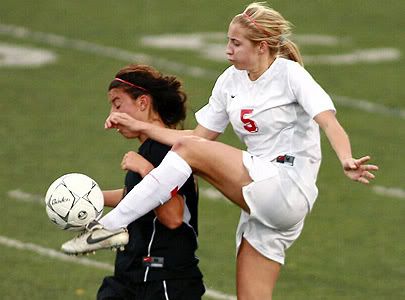 The physical courage, not to mention the personal sacrifices that female athletes are remarkable -- in many cases it exceeds that of the men, even though the tangible rewards (i.e., huge stacks of cash) aren't as obvious.
The physical courage, not to mention the personal sacrifices that female athletes are remarkable -- in many cases it exceeds that of the men, even though the tangible rewards (i.e., huge stacks of cash) aren't as obvious.Michael Sokolove's forthcoming book, Warrior Girls: Protecting Our Daughters Against the Injury Epidemic in Women’s Sports, which is excerpted in this weekend's New York Times magazine, seems well-timed. It's a tough story to boil down to a couple paragraphs ... basically, the march toward equality on the playing fields has also meant that female athletes in some sports -- soccer, basketball, volleyball -- suffer major knee injuries at a higher rate than the guys by a factor of five in some cases.
There's also potential sexism in focusing on problems in women's sports when the success stories tend to only get lip service in the media. It's wonderful that we're in an age where a super-competitive female athlete can go for it from an early age and isn't told, "well, that's a nice hobby." That was a subtext to a feature I wrote for the Ottawa Sun a few months ago about a young hockey player named Isabel Ménard, who's in the Sport-Etudes program at Louis Riel, where during this winter she would be on the ice each school day, often doing drills alongside a possible future NHL defenceman, Erik Gudbranson, the Kingston Frontenacs' top choice in last week's OHL draft.
I only mention the above example to show the progress that's been made in the past decade or so. N The thing is, when studies show that young women absorb major injuries at a much higher rate than males in the same sport, it is worrisome. By the same token, there's a defensiveness there, since there's a worry about showing weakness and giving ammunition to the arguments against things such as Title IX, the catalyst for women getting more opportunities in sports in the U.S.
Sokolove points out that in youth sports and the U.S. military, there's evidence that females have a higher tolerance for minor injuries; the guys are more likely to beg out over a minor ailment.
See? It's complicated. Please give it a read.
(While we're here, best of luck to a couple of Ottawa-area shinny stars -- Isabel Ménard and Jamie-Lee Rattray, of Kanata, have each been invited to a national under-18 program camp in Calgary later this month. Two others from the region, Wisconsin standout Jasmine Giles and UConn's Dominique Thibault, are going to the under-22 team's camp.)
Related:
The Uneven Playing Field (Michael Sokolove, The New York Times Magazine)






4 comments:
Interesting stuff. The biomechanic preventative approach seems promising: perhaps they could work something into coaching clinics to try and identify players with poor form that puts them at higher risk of injuries, and then recommend those players to biomechanic specialists? That could prove useful for both genders.
What I found concerning in the article is the criticism of the club structure, though. Early specialization can be problematic (and I've talked with plenty of high-level coaches who prefer their recruits to have played several sports, as that tends to help develop different areas of skills), but I don't like the idea that we should go back to a focus on fun. In my mind, the best approach is to emphasize to all athletes, male and female, that serious injuries can result from competitive sport.
Some will use these kind of statistics to try and argue against women playing at high levels, which is a dangerous road to go down: I'd much prefer it if we focused on injury prevention and education. Women's soccer and volleyball certainly aren't as safe as they're sometimes made out to be (and the same occurs on the men's side), but that's no reason to try and reduce the amount of people playing or the numbers of games. Sports are a dangerous activity, but as long as those involved know the risks and are willing to take them, that's all right in my books.
Also, the other thing this article shows is that anyone who calls soccer (men's or women's) a wimpy, non-contact sport clearly hasn't played it and doesn't know what they're on about...
Gender equality in sports, if I remember my French feminism, was treatment that recognized the difference between the sexes... the article did point out some solutions.
I do wonder if there's any cause-and-effect between the injury rates and the number of male administrators and coaches in women's sports (the rate of female head coaches in NCAA women's basketball, IIRC, has dropped since the '70s). Of course, we don't know if it would be any different if you had more women coaching who had been through the same rigours.
Anyway, that book should foster some debate among the sports scientists/sports sociologists.
Murray Costello, when he was the president of Canadian Amateur Hockey Association (now Hockey Canada), had a great answer when he was questioned around the time minor soccer exceeded minor hockey in participation numbers: "I hope as many of those soccer players as possible are hockey players taking a break."
It would be really boring to only play one sport.
Post a Comment